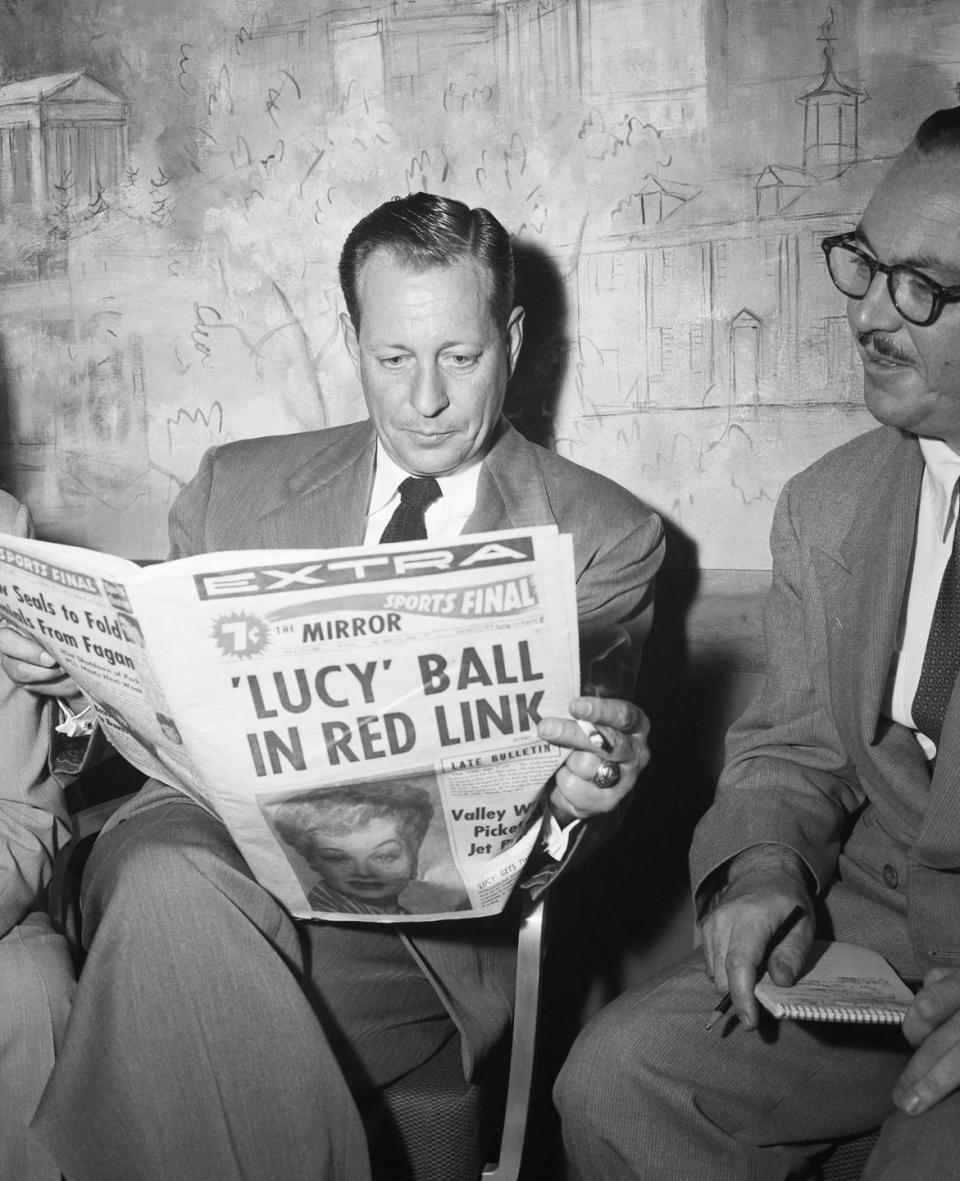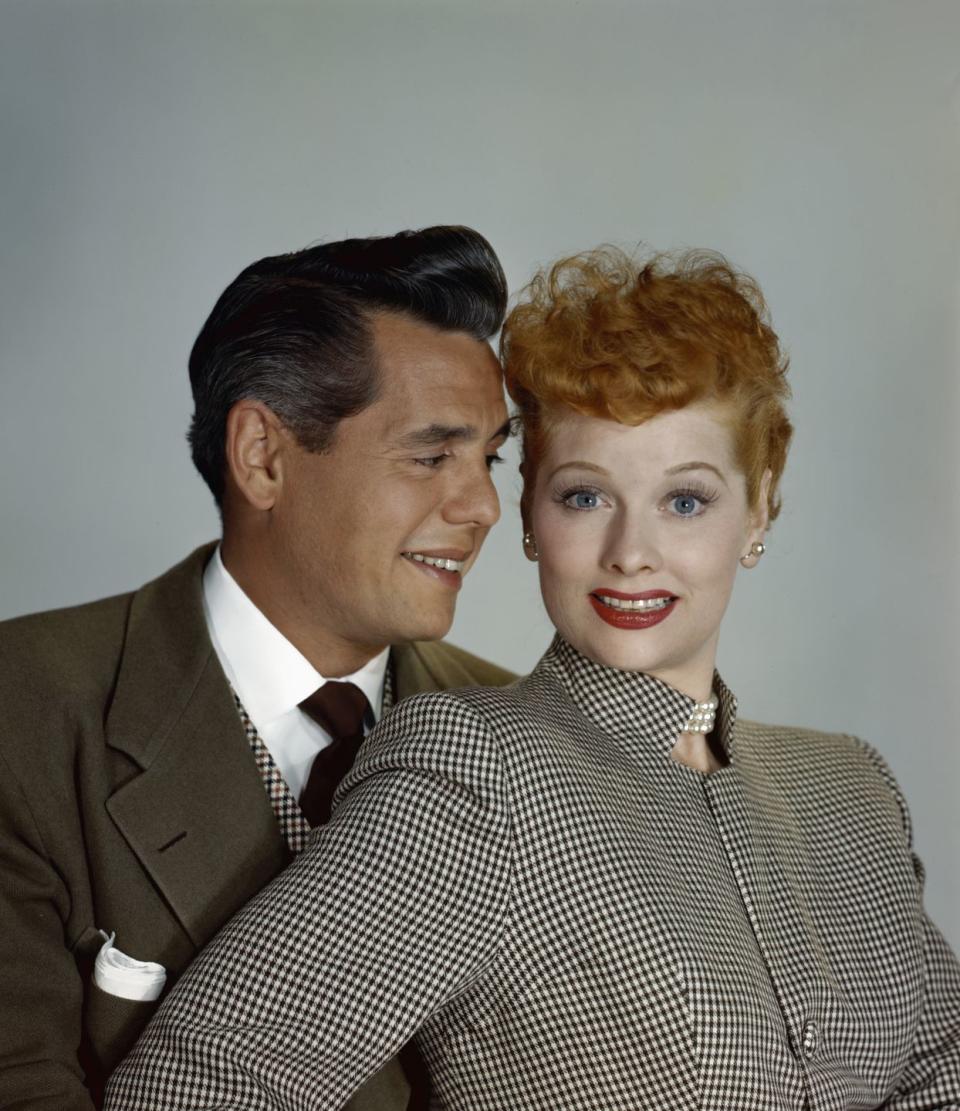When the Red Scare Came For Lucille Ball

- Oops!Something went wrong.Please try again later.
In her heyday, Lucille Ball was one of the most powerful women in America. I Love Lucy dominated the small screen, averaging 15 million viewers (or nearly 60% of American households) weekly at its peak. Ball and her husband, Desi Arnaz, committed acts unseen on television before—you know, real salacious stuff like being in a mixed race marriage and being pregnant... in plain sight of television viewers. Those feats may seem small by 2021 standards, but at the time, a pregnant Lucy Ricardo was one of the most groundbreaking moments in pop culture history. The only thing that seemingly could have taken Ball down was one nine-letter word. Communist.
In 1953, at the height of the second Red Scare, Hollywood's elite were being dragged into a damning limelight if anyone found reason to suspect them of being a communist or a communist sympathizer. Ball became one of the most notable subjects of the era, landing in a precarious position when it was revealed she was attached to the party about 15 years prior. It makes for excellent fodder for Being the Ricardos, which wisely follows a crisis-riddled week in Ball's life (as opposed to a full biopic). But not everything in Aaron Sorkin's new film is 100% true. The true story of Ball's brush with communism is a bit less cinematic than the creative team paints it to be, though she very much was at risk of losing everything that she had built her empire upon.

The Second Wave of the Red Scare
To understand the severity of Ball's situation, you first have to understand the severity of the Red Scare in America. Both waves included a fear of the rise of communism in America. The first one originated from a combination of real events and fear: namely, the Russian October Revolution following World War I (real) and the American Labor Movement (also real). What people feared, though, is that far-left and workers' rights groups were organizing anarchist moves to dismantle American democracy (not real).
The second Red Wave started in the late 1940s and is characterized by McCarthyism, a thought outlook named for Senator Joseph McCarthy, as he employed all types of fear-mongering tactics aimed at exposing communist sympathizers and socialism activists in the United States. He touted a list of names that worked as insiders pushing a socialist agenda within America. McCarthy and the work of those who believed in his cause led to the blackballing or a number of prolific American celebrities, especially those involved in the arts. To some extent, Dorothy Parker, Arthur Miller, W.E.B DuBois, Langston Hughes, Dalton Trumbo, Albert Einstein, and of course, Ball, were involved in the controversy.
What Happened with Lucille Ball
Ball's controversy stems back to 1936, when she registered to vote and affiliated herself with the Communist party, along with other members of her family. Later, Ball maintained that she did so to "appease her socialist grandfather," but she was never an active member of the party. This however contradicted a testimony given by Rena Vale, a Hollywood writer and Communist, who testified in front of the House's Un-American Activities Committee that she attended a new member class at Ball's residence around 1937. (Naturally, that wasn't a great look for Ball.)

In 1953, Ball voluntarily met with the House Un-American Activities Committee to clarify the situation, repeating that she had only registered as a Communist at her grandfather's behest and never actually self-identified as such, or as someone who would vote pro-Communist. The testimony was forwarded on to J. Edgar Hoover, who served as the FBI director at the time. Ball was cleared of any suspicions. That didn't stop the Los Angeles Herald-Express from publishing the headline "Lucille Ball Was Red in 1936." In bold red letters, the headline had the power to potentially ruin her career.
As I Love Lucy was shot before a live studio audience, Arnaz (who routinely warmed up the crowd before shows) thought it best to continue as planned and address the situation head on. Before shooting episode 68, "The Girls Go Into Business," Arnaz addressed the crowd, allegedly saying, "The only thing red about Lucy is her hair, and even that's not legitimate." Later that year, President Dwight D. Eisenhower invited Ball and the rest of the principal I Love Lucy cast to celebrate his birthday in Washington.
What The Movie Changed
The movie takes a few liberties with what happened. Perhaps one of the less noteworthy differences it that the episode chronicled in Being the Ricardos, the week of Ball's dust up with the U.S. government, was purported to be episode 22, "Fred and Ethel Fight." That episode has been filmed the year prior to this real-life scandal, but because of the small nuances within the episode, the wardrobe, and how well it fit into the larger story (which also tackles Arnaz's suspected infidelity), the film decided to change which episode was being covered.

Though the film doesn't show Ball's testimony in front of the House of Representatives, it does allude to the fact that there's a discrepancy between what Ball told the members of the government and what Arnaz wanted to tell the public. The couple quarreled, with Arnaz saying that they should communicate that Ball simply "checked the wrong box" when registering, though the image of her voter registration card on the Los Angeles Herald-Express shows that "Communist" was written on the card, not checked off.
Perhaps one of the biggest differences it that before Arnaz (played by Javier Bardem) comes to warm up the crowd, he and Ball (Nicole Kidman) have a conversation about the importance that she is cheered for, not boo'ed. The surefire way to make that happen... at least in film? Get a reliable source. After Arnaz addresses the crowd, showing off the early edition of the paper and assuring the audience and attending journalists that Ball is not a communist, he gets someone on the phone to confirm it for everyone in attendance. He puts the speaker to the microphone to reveal it was Hoover, himself.
That... did not happen. But Ball's reputation remained in tact and recovered fully in the following months. And now the prevailing legacy is Lucille Ball, American treasure.
You Might Also Like

